Honey Cyclocross: Sweetly Different
Aside from their obvious use for cyclocross racing, 'cross bikes can be a good choice for unpaved riding - something I've been apparently doing more and more of in recent weeks. So I wanted to try one and compare the experience to the 650B road-to-trail type bikes I've been riding thus far. Ride Studio Cafe's manager Patria offered her personal steed - a women-specific, true cyclocross racing machine from Honey Bikes. Patria and I are similar in height and we use the same pedal system, which makes it very convenient for me to try her bikes. One day when she wasn't riding it, I took the Honey out for a spin.
A small local manufacturer, Honey Bikes are a sister (or cousin?) company to Seven Cycles, specialising in modestly priced, handmade steel bikes. The Honey brand is not promoted aggressively, and the aesthetics are low key. Models include road, race, cyclocross, mountain, tandem and commuter bikes - each available in sizes configured for men and women, with size-specific tubing. The bikes are sold fully built-up with a selection of component groups and stock colours, priced starting at $2,000. These are not custom bicycles and the comparatively reasonable prices are achieved by sticking to stock configurations. However, the choices for those configurations are extensive - particularly the wide range of sizes. The cyclocross model is available in 12 sizes, ranging from 49.5cm to 62cm, measured by the top tube.
Patria's bike is a 52.5cm according to the Honey sizing system. The toptube slopes 8°, exposing quite a bit of seatpost despite my rather unaggressive bar to saddle height ratio (Normally the saddle is set up a tad higher than shown here).
There is no toe overlap for me on this bike despite the 700C x 35mm knobby tires and short top tube.
The frame has a nice flow to it and is cleanly finished; the welded joints appear seamless under the paint. For those in the know, the curvy stays and sculptural dropouts are tell-tale signs of the relationship to Seven.
The body-colour stem and all-black components give a sense of unity and flow to the overall look of the bike.
One interesting feature that is typical of cyclocross bikes, is the cable routing. All three cables - the shifter cables and the rear brake cable - are routed along the top of the top tube.
This is done so that cyclocross racers can carry their bikes more comfortably, and so that the shifter cables (normally underneath the downtube) do not get covered in mud.
The carbon fiber fork is made for Honey Bikes specifically, with canti bosses.
Lots of clearance for wide tires here, I believe 40mm being the maximum width.
The tires on the bike when I rode it were Schwalbe Racing Ralph 35mm.
The SRAM Rival drivetrain and levers were new to me, but it did not take long to figure out the double-tap shifting. I can use SRAM brake levers much better than Shimano, though I still prefer the Campagnolo on my own bike.
I rode the Honey on a local dirt trail, then on the road, then finally in circles on a grass lot before returning it to its owner. It was not a long ride - maybe 12 miles total. The ride quality over rough roads was smooth and the bicycle felt pleasantly floaty. At the same time, the wide tires were amazingly stable, and I fondly recalled the reassuring go-anywhere feeling of knobbies from my teenage years. However, that is where the sense of familiarity ended. Having ridden a Surly Cross-Check before, I thought that I knew what to expect from a cyclocross bike, but this was a different animal. As far as the handling, the novelty factor dominated my impression. The weight distribution was not what I was used to, and the bike felt somehow simultaneously more relaxed and more aggressive than the roadbikes I've gotten to know. I found myself standing up more than usual, and in general it was as if the bike wanted me to ride it differently than I normally ride. What I remember thinking was: "I can tell this bike is meant for something specific. But it's not meant for me." Still, the test ride was enjoyable precisely because of the novelty factor and the challenge of understanding the handling. I felt comfortable and reasonably confident on the bicycle, yet aware that it was designed for someone with a different riding style than mine.
Unlike me, the bike's owner actually races cyclocross. She finds the handling spot on, as do other cross racers who've tried it. The Honey is certainly worth considering for those looking for a racing bike just in time for the cyclocross season.
As far as general road-to-trail type riding for the rest of us... Well, in theory the Honey Cyclocross is suitable for that as well. I noticed that the gearing on the stock drivetrains is somewhat high, so you may need to tweak that. But features such as the wide tire clearances with no TCO, the canti/v-brake bosses, the variety of sizing options, and the lightweight components, are very appropriate. As described earlier, I would say the handling is rather particular; you may want to test ride the bike first. But that is exactly what I would say about low-trail 650B bikes, whose handling feels intuitive to me but strange to others.
For a US-made frame with an elegant contemporary aesthetic and mid-tier components, the price point of the Honey is certainly appealing. I am curious about their other models, and in particular find myself wanting to try the mountain bike. Those knobby tires have really put ideas in my head. Many thanks to Patria for lending me her Honey Bike! Full set of pictures here.

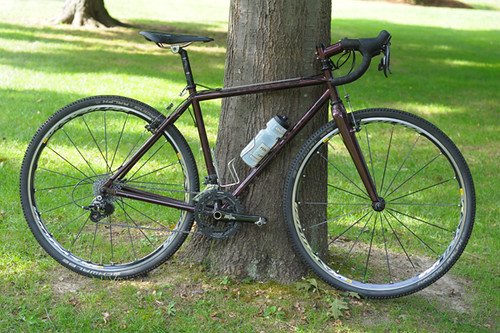






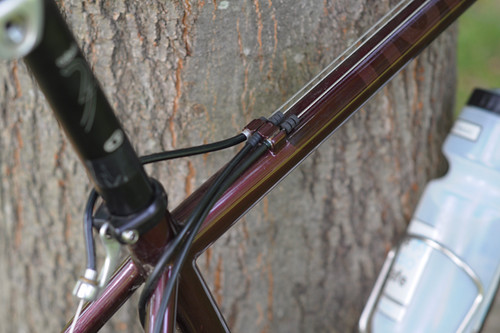
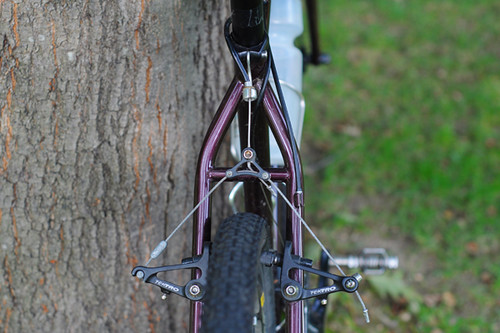

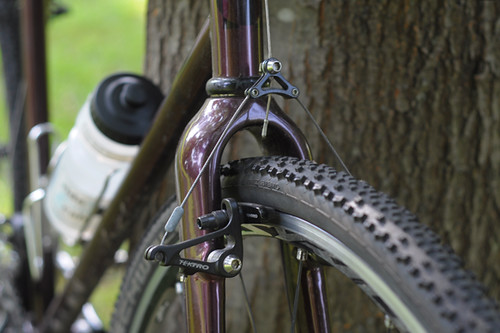


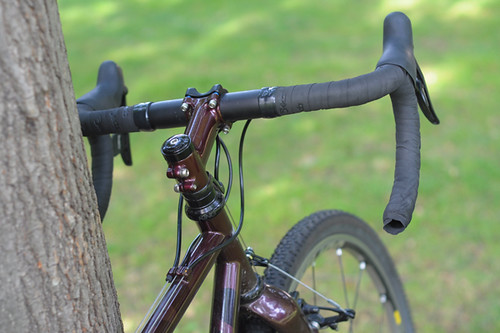
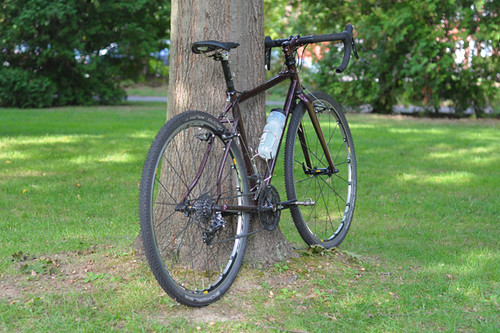
My own cross bike has fender and rack mounts, which considerably expand utility.
ReplyDeleteTrue it is not for utility cycling. They explain in the model description that the bike is purely for cyclocross. There is a separate model for commuting.
DeleteNice looking bike, but if I was getting a CX today I would get one with disc brakes, at least in the front. Probably not needed for actual CX but for commuting in the wet it is great. I have had those same Tektro brakes and upgraded ti beefier shimano brakes.
ReplyDeleteDid this one have fender mounts?
No, no fender mounts.
DeleteA cyclocross bike is what I really wanted back in 93 when I bought my first bike as an adult but they were a little harder to come by back then. I still loved the mountain bike I bought (and rode the wheels off for 13 years!) but I usually ended up carrying it over the really difficult obstacles anyways so a cross bike would have been fine (and better for when I was on the road). Actually an XO-1 would have been great too but I couldn't get a Bridgestone dealer (or Bridgestone themselves) to sell me one so I felt it served them right when they went out of business with a warehouse full of unsold bikes! I've been riding a Kona cross bike similar to the Honey in spec since 2007 and love it. It's nice to be able to ride (relatively) fast and (relatively) effortlessly on pavement and then turn down some singletrack on a whim all on the same ride.
ReplyDeleteI've had the same lack of satisfaction with cantilevers. It surprised me because the stock cantis on my mountain bike worked wonderfully and the Avid Tri-Aligns I replaced them with were even better. The Avid Shortys on the Kona were pretty bad though. I replaced them with Paul cantis and those actually work rather well (given the price they had better...) but I still kind of wish the UCI had allowed disc brakes on cross bikes.
Nice looking bike. Did you notice any juddering of the front fork under hard (front) braking. I ask as I had to modify a Specialized Cross bike with Carbon-fibre fork that came with the same front brake set-up as the Honey, in order to cure an dangerous amount of front brake judder.
ReplyDeleteOf course it is possible that the Honey's fork is a little stiffer.
I did not notice any juddering in the fork, and I did try to brake hard and often, as I was testing the braking power. Of course my test ride was limited.
DeleteRichard; how did you modify it? I had some juddering on the front brakes of my Kona (carbon fork) Major Jake. In my case it turned out that the problem was that Avid didn't do too good a job when it came to making the pivot bushings on the brake arms either round OR to reasonably tight I.D. tolerance. The Paul brake arms had virtually no detectable slop when fitted to the fork and this completely cured that problem. I was afraid that it might have been caused by incompatibility between the fork flex characteristics and wheel diameter. It was quite a relief to discover that it was just due to the Avid brakes not being very good. I was a little disappointed because the Avid Tri Aligns I used to have were amazingly well made and thought the Avid Shorties would be just as good.
DeleteThere is a factory fix for the Specialized brake judder. It worked. I suspect the fix would work on any other cross bike as long as the front fork is drilled at the brake bridge which the Honey is not. Details at dfwptp.blogspot.com and search using the term newfangled brakes
DeleteApparently Tektro makes something similar but I've never seen one.
@nowhere
DeleteThe problem with the Specialized relates to the upper anchorage point of the brake cable outer sleeve. This was fixed just below the handlebar as for the Honey (see photo above). When the cantilever brakes are applied this causes the carbon fibre fork to flex backwards, thereby tightening the brake cable and hence increasing the bite of the cantilever brakes. Eventually the rubber brake pads flex and release the wheel, the fork springs back and the brakes re-engage. The juddering occurs when the resonant frequency of the fork is such that it is stimulated by the snatch release braking effect that is a result of the long distance between the upper cable sleeve anchor and the cantilever. While it is sometimes possible to cure this by changing the brake pad compound, simply moving the cable sleeve anchorage down to the crown of the fork, or replacing the cantilevers with V-brakes, solves the problem. See the above link given by Steve A.
Nice paint. Liquid or powdercoat? Color name or RAL?
ReplyDeletePretty sure it's liquid. Two-tone (logos are a shade darker than main colour), this year's choices listed here. I doubt they'd reveal the colour codes!
DeleteWell, it's not any of this year's colors. Looks a little like the "purple passion" color of the old Kleins, w/o the bronze under/overtones.
DeleteIt seems like most bikes are designed with a bit of compromise inherent. Very few are fortunate enough to own a stable of bikes built for specific uses so are forced to make choices which allow a single bike to function for a couple different purposes. This one seems quite specific with it's design and is probably killer on a technical course where jumping out of the saddle is necessary. Looks great, too, wow!
ReplyDeleteNot surprising that the Surly you road had a completely different feel, especially with the Fat Franks installed :) Those are nice compromise bikes.
I've tried the Cross-Check with some 35mm knobbies as well. Either way, the handling felt more normal-bikish than the Honey. The Cross-Check is also a considerably heavier bike.
DeleteIt's clear that the point of the Honey is to put together a comparatively affordable bike for someone who wants to race. There is a way to get fenders, etc on the bike without eyelets for those who really need for it to have more utilitarian functions. Same with racks, dynamo lights. The bike won't look as elegant as it does now, but technically it does not have to be a 1-trick pony.
The handling... makes me wish I had better handling skills : ) I can feel what it is meant for; I just can't do it.
You know, there's only one way to get better bike handling skills.....Let go and give a muddy course a try. What's the worst that can happen?
Deleteso, what felt wrong about the cantis? i rediscovered them on an old kona, and found it a revelation of powerful, manageable braking and, joy oh joy, never getting clogged with dirt, no matter what swamp you're wading through. i think bikes use geometry to make one ride different, the kona (my infatuation of the moment) feels like a cycling equivalent of a series landrover, unbreakable and somehow nudges one playfully out of the saddle after ten minutes in the direction of a log that hasn't been lofted
ReplyDeleteIt's not just cantis; I had the same problem on the wide-mouth sidepulls I tried on the Rawland. Basically, I have not yet tried a bike with wide (>35mm) tires and drop bar style brake levers where the stopping power has been truly confidence-inspiring. It could be my hands' limited strength in combination with those other factors, don't know. Centerpulls have worked for me on bikes with 35mm tires, but I haven't tried wider. I should try V-brakes.
Deletethis may be obvious, but wide tyres generate much more stopping power/friction and can make the brakes "feel" the weak link - I had a balloon bike I put (I think 2.5, anyway the fattest) big apples on which made the brakes (that felt mediocre but OK before) noisy and fady. put differently, if I had to rely on the cantis to stop me while careering down a hill at 40 mph, I'd probably have a different view of them
DeleteI think cantilever brakes consider your stop request as just a suggestion. Which in a cross race is good enough.
DeleteSeriously, when I shift from riding my cross bike with cantilever brakes back to my road bike or (worse) my hydraulic disc-braked mountain bike I almost go over the handlebars when I brake.
My only slower braking bike is my 48 pound steel Dutch bike with drum brakes in the hubs.
Cantis have built-in potential for tuning. The calipers in the photo have abundant clearance for adjustment to the straddle cable and cable yoke. That's the beginning. I have an older version of the Tektro in the photo and there's lots of power.
DeleteIn a cyclo race everything is intense exaggerated and high torque. You wouldn't want sensitive brakes.
You might want to have at least one of your bikes set up with vintage calipers that have strong springs. Hand exercisers. The Mercian effectively has a foot brake and would look great with a more architectural caliper.
Yes Velouria, you should try V-brakes, truly jaw-dropping braking power with control, though not quite so dependable in all conditions as discs.
DeleteThis must be the ugliest bike you have reviewed so far. Couldn't they find you another one in a nicer color for review? Components are fine, quality seems to be pretty good as well, but that paint...yuck! It looks so cheap. The moment I opened your blog this morning I thought "What? Velouria is reviewing some Walmart crap now?"
ReplyDeleteTo each their own. I actually like the look of the bike. The dark cherry colour would not be my personal choice, but then neither would orange or yellow or blue, or a dozen other colours others love. I think the two-tone paintwork and the black components are a very clever way to make the bike look streamlined and a little mysterious. The frame is seamless at the joints, unlike most welded bikes you'll see in stores. The components are solid. It's a modern aesthetic, but by no means "cheap" looking. There is a difference.
DeleteOh dear! Looks cheap? Looks ugly? My eye sees something elegant, understated, quick, and ready for action! Nice lines, no contrasts -- which anyone can do -- and nicely put together. I'd be thrilled to pedal something this sweet around, even if it's most practical for cross riding.
DeleteHmm I liked the colour I want something like that or maybe a bit lighter for an old Corima Puma frame I bought for cheap that need a new paintjob.
DeleteThis is a VERY classy looking bike!
Deletebut it does seem very angular, the fork, the top of the rear triangle - it sure isn't a Herse - and so quite aggressive, if i saw it first thing on a Sunday morning, a pleasant cruise to the cafe wouldn't cross my mind
DeleteIf you look at the bike in perfect profile, it has no curves - all angles and straight lines. Straight fork, which I normally dislike. But if you change your vantage point even a little, there is all this interesting stuff going on: the signature Seven stays and dropouts, the way the seat stays open up in the rear, the subtle faceting on the fork. It's all surprisingly intricate on close inspection. A Herse it is not, but it's a Honey.
DeleteI like the sharp angles on the bottom of the rear drop-outs, a bit like the love-child of a Hetchins (bet you cant come up with another H!), and it does seem compact (which is always good), but I somehow understand the colour, it seems a little menacing, like the curves
DeleteThe cross cx isn't in the same league as this bike.
ReplyDeleteConsistent with ability is practice -- 12 miles does not make one better at riding it. Plus it's not set up like yours because of rider differences and cx bikes have less weight on the front
V-brakes. You forgot you hated them when you tried them. Of course they work, they are v brakes.
Yeah, V-brakes are massively strong. I just wish I liked the way the look, which I don't. I always associate them with really cheap bikes. I should get over it, but it's what it is.
DeleteI've tried v-brakes only on upright bikes so far. They work "too well," which is what I didn't like. But I'm wondering whether on a drop bar bike they might be just right if cantis are too weak for me. Hard to say of course without trying.
DeleteRe v-brakes looking cheap: What about Paul's Motolites? Either way, I am not sophisticated enough to care; would cheerfully use v-brakes with a Chorus group as long as they did what I needed!
Dudes, we've had this convo before.
DeleteState of the art stopping in cx is vees, with discs here now.
Vees were on that heavy Urbana, work better on a lighter bike? Methinks user error is the culprit, goes to "practice" vs. "trying" or "testing". Momentary impressions of bike stuff don't hold.
Oh yeah knobby tires -- swat I been sayin.
If the Paul Minimoto had been around when I bought new brakes for my cross bike I would have tried them first. A linear pull designed for short pull levers? Who do I pay? Personally I LOVE being able to get full braking power with just a couple of fingers on the lever. As they hadn't been introduced at the time I went with Neo-Retro and Touring cantis. I actually really wanted to put "v-brakes" on my mountain bike back before Shimano made them. I read an article about the new linear pull brake design from Ben Capron and Marinovative and thought the idea was ingenious. When I went to my local bike shops and asked about them they had never heard of them and seemed to think it was something I had hallucinated in a fever dream.
DeleteIf I loved anywhere near you - and if I didn't ride a 58cm. frame - I think I would probably cave in and put a set of the Minimotos on the bike just to get it in featured in a review here!
Surprised by Somervillain's notion that v-brakes look cheap. The old Shimano XT v.brakes with the parallel linkage to maintain the pad surface always parallel to the rim surface was to my mind, a piece of art.
DeleteShimano still sell this wonder but call it XTR and charge a lot of money for it. From an engineering viewpoint the v-brake concept is excellent.
Well set up, good cantis will stop anyone. I've used 4ZAs cantis and now have TRPs Revox (ok revox is a modern canti, but still). The Revox are great, depending on how you position the yoke you get completely different brake feel; two fingers over tyre will pop your eye balls, 5-6 fingers give you super mud clearance and modulation but no power. I now have 3 fingers high and great modulation and will lock my wheels easily if I squeeze hard. Brake pads are also vital, I only use SwissStop
DeleteA lot of cyclocross folks seem to use the mini v-brakes with their standard road levers--or some have a travel agent installed--and love it. I kinda dig the look of Paul mini v's.
ReplyDeleteThe new Pauls certainly photograph well. Have not seen them in person yet.
DeleteWhat few reviews are out there are positive.
I had Paul Motolites on the Bruce Gordon Rock and Road I used on my coast to coast tour. They gripped hard first time every time. In fact when I first started riding the BG I frequently overbraked.
I thought about discs as well. Seemed a bit complicated for the task. As it is, braking was not among the problems I had on tour.
So, you saw a lot of low trail, 650B, steel bikes at D2R2. Do you recall seeing many cross bikes there? If so, were they modified somehow to work better for a longish, more tame, type of riding? What were the makes? Seems I hear a lot about Salsa Vaya as an choice if strictly cross bikes are too intense an option.
ReplyDeleteIf you visit the post and the accompanying picture set, you will see many cross bikes! The only modifications I saw were additions of bags. There were a few Salsa Vayas.
DeleteI wonder if it was the knobbies that made such a difference to the handling. I suspect that if the bike had a smooth tire like the Grand Bois Cypres, it might handle a little more like what you are used to. We'll have to test this theory by getting you on my Redline with these tires... or trying these tires on the Honey...
ReplyDeleteI think the Cypres tires would be too narrow for me to comfortably ride the bike on unpaved roads and trails. I actually really liked the 38mm knobbies. But I would love to try your Redline, yes indeed!
DeleteHey, I've seen you ride 23mm on dirt.
DeleteIs there a 38 Ralph? Or do you mean 33? I have not seen nor can I find a mention elsewhere of a 38.
DeleteIf a Cypres would do it for you if it were wider you can get that tire. It's called a Rivendell Jack Brown. Peas in a pod. The Cypres is 31.5-32mm, the Riv is 34.5-35mm.
Challenge Grifo XS, heavy file tread, 34mm, walks away from any of the above and works well on pavement.
For competition it's all tubulars now. Riders on tubulars use lower pressure and take entirely different lines than clinchers. Faster lines. The wide tubulars are easier to patch and get surprisingly few punctures. Offroad they flat less than clinchers. Comfort in a different world.
All of the above require wide rims to achieve their potential. Even for those who will not max out their tires, the wide rims make the bike feel planted, encouraging steeper turns.
Hmmm you know I was told it was a 38mm and didn't question it. I didn't see the width written on the tire itself. Now I looked it up and cannot find mention of a 38mm either; will ask tomorrow. The tires felt and looked wider than 33mm, but could be placebo effect!
DeleteFor correct sizing you almost have to own a vernier caliper and use it. Use it again when the tire stretches. Then it all changes year to year. New UCI regs mean some (which?) tires will now be narrower. Some makers will let us keep the old wide ones (if we promise not to race them), some won't.
DeleteIf going offroad do not be afraid of sewups. The better casings are just as flat-resistant as the Cerfs you are using now. Pinch flats are way more common on dirt and the tubulars almost can't do that. Skinny tubulars tend to distort after patching until you get very good at it, the wide ones are not a patching problem at all. The big problem might be you'd like the smooth ride so much you get addicted.
Never tried CX tubulars.
DeleteBut I wound up selling my tubular wheel set and FMB Paris-Roubaix after trying Cerfs on my road bike.
Cerfs' ride quality was just as good on pavement and maintenance easier for me anyway.
Hi Matt
DeleteJust go watch a cyclo. It's become like two separate but unequal events happening at the same time on two roughly congruent courses. The clincher racers dive into the turns and sprint out of them. The tubular riders take a shorter line, use far less brake, and flow through the turn. Clincher riders who try to follow the tubular line slide out and flat out.
The difference is not so pronounced on pavement. For simple minimum rolling resistance - speed - your Cerfs could be faster than FMB. They aren't any slower. Past that all I can say is there's no accounting for taste. Wish I'd been there when the wheels were sold.
I borrowed this bike again for the Kearsarge Klassic over this past weekend and found the size on the tire. They are in fact 35mm. I will change the text of the post.
DeleteI'd save grand and get a Raleigh Roper. I could actually use it as a distance commuter once the whole cx thing got old for me. I don't mean to dis the Honey Cyclocross on its own terms, just saying that most people are subsidizing a ROI when they buy it.
ReplyDeleteI wouldn't buy the Honey CX but I would consider a road Honey if I were looking for another steel frame. Seven/Honey builds beautiful frames and are a decent deal for the money, if yodocile the component mix.
DeleteI have Avid Shorty 4, which stop just fine with the Kool Stop brake pads. The centering mechanism is bizarre and makes me want to try the Paul touring Canti.
Youdocile was "you like". Thanks iPad auto correct program.
DeleteI always wonder how it is for someone to loan you a personal bike, one they no doubt love and enjoy, only to have you review it and us riff-raft comment on it :) Special thanks to the owners of these bikes!! Really, the point is finding a bike one loves and enjoys for whatever use and ignore the peanut gallery.
ReplyDeleteIf we all liked the same kind of bike, things would be kind of boring.
DeleteBut yeah... this is someone's personal bike and it would be nice to keep that in mind. Thankfully the owner is cool enough not to mind the banter.
Well, yes, all bikes are someone's personal bike. And there is always going to be perjorative "peanut gallery" and "banter" reactions to comments and thoughts about bikes. As if "banter" is something to be not minded. Comments/banter/evil peanut gallery help this blog and its audience?
DeleteI try not to overmoderate and it's hard to know where to draw the line between removing rude comments vs censoring opinions. The way I see it, a person has the right to opine that they strongly dislike a bike's aesthetic. Could it have been expressed nicer? Yes. But when someone is a long time local reader I give them the benefit of the doubt.
DeleteOn a separate note, I think it is interesting and useful to know that some associate a modern aesthetic with cheaply made "Walmart" bikes. On the flip side of that coin, it is easy for companies to use a superficially classic aesthetic to mask poor craftsmanship.
Don't overmoderate,if you can avoid it. I enjoy the contrary opinions although I can't agree with many of them and often wonder why you didn't cut them ...
DeleteI have taken close looks at many Honey bikes and they are all quite nice. I suspect the color translation to different monitors doesn't help and your low resolution photos don't always show the details of the bikes.
I recall a black matte Honey single speed commuter owned by an employee of RSC a couple of years ago. I still want that bike (with an IGH). The aesthetics works for me, modern or not, and don't resemble in any way a bike Walmart might sell.
I'm going to post a picture of the honey Honey 8 speed (IGH) with disk brakes that I see often on my commute. Walmart would never sell that bike, or anything so nice.
I think it's a nice looking bike. The color reminds me of the eggplants growing in my garden right now. The banter is helpful for me as I try to fine tune the ride on my '91 Volpe. It's kind of a cyclocross bike that I've tasked with commuting which includes some dirt trails. I'm not crazy about the Vittoria Randonneur 32s I'm riding right now and am considering trying Scwhalbe Dureme 35s instead. I'm also not blown away by the canti braking power. I'll have to look into the mini Vs that were mentioned.
ReplyDeleteFirst the Nordavinden, and now this Honey.
ReplyDeleteTo think that only a short while ago many of us were tempting *you* into venturing outside your comfort zone. (grin)
I think this is an awfully good looking bike, and would be interested in seeing one in person. Those curved stays are one of the coolest things about the Seven bikes; they translate really nicely to steel.
And the color is quite appealing to me, somehow. The barely contrasting lettering is a deft touch.
After a relatively quiet summer, I've had a sudden burst of confidence over the past month where I went from merely being willing to ride on dirt if coaxed, to actually enjoying it and suggesting it myself. This could get interesting.
DeleteClean sweet air, passing from the shadows of the trees into a sunny clearing, wildflowers, stream crossings, no cars roaring past... I think you'll end up really loving it. Considering how much you've managed to accomplish in road riding in a fairly short time I wouldn't be too surprised to read a post in the not too distant future about going down the A-Line trail in Whistler.
DeleteI'm the owner of this lovely Honey bike and I really appreciate Velouria taking it, riding it (bikes are meant to be ridden!) and reviewing it. I've enjoyed reading the comments and am happy for people to critique it. This bike has brought me hours upon hours of fun in the unending woods not far from my home--a kind of riding I never knew or enjoyed prior to this bike. Its handling is solid and nimble at the same time. The Schwalbe Racing Ralphs are great tires, perfectly complementing the bike & ride. This Honey has brought me many awesome times I otherwise wouldn't have had.
ReplyDeleteDuring the months when I was without a road bike, I often swapped out the knobby tires for road slicks so I could go on road rides. It rolled for hundreds of smooth, great miles. It took a little to get used to the slightly more upright geometry inherent to CX bikes. Other than that, I didn't notice a difference between the ride of this bike and a well-built road bike.
The color is called Chocolate Cherry Metallic and I agree with everyone who describes it as classy, elegant and beautiful. It is very eye-catching in such a subtle way.
Interesting about the road slicks. What size road tire did you tend to use?
DeleteAlso, how do you like the way it feels during extended climbs?
Thanks for adding the extra comments!
Enjoy the upcoming season--get muddy!! And thanks for sharing :)
Delete"During the months when I was without a road bike, I often swapped out the knobby tires for road slicks so I could go on road rides. "
DeleteYes she did : ) Thank you for the great rides Patria.
Corey - I used regular 23s. Bike feels great climbing, it very confidently ascends and descends.
DeleteVelouria - And great to ride with you, too, we'll need to go again sometime when you're not off doing some crazy cool rides out of the area!
What a beautiful bicycle! I especially love the cool color and understated graphics. It looks like the kind of do-everything bike that lasts a lifetime.
ReplyDeleteSo, the front derailleur cable comes down from the top tube? If so, does it require a special front derailleur?
ReplyDeleteThat's quite common for cyclocross bikes. The setup can either use a pulley brazed on the seat tube below the FD clamp which reverses the cable direction or a special top-pull RD like the new Shimano FD-CX70.
DeleteIf the gear cables ran down the downtube, your hand could tug at them when picking up the bike (as in crossing an obstacle on foot). If that tug moved the shift lever position, you'd be shifting as you pedalled away after the remount (not smooth). MTB's often use downtube mounted cables, so it's not about mud. (The old-timer has now spoken.)
ReplyDelete